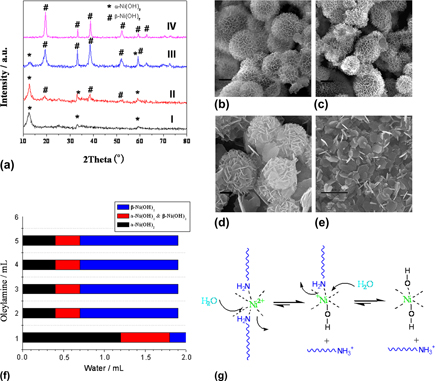Crossref Citations
This article has been cited by the following publications. This list is generated based on data provided by
Crossref.
Gou, Ye
Liang, Xin
and
Chen, Biaohua
2013.
Catalytic hydrogenation of acetophenone over shape controlled Pd catalysts supported on sheet-like NiO.
Catalysis Today,
Vol. 216,
Issue. ,
p.
200.
Song, Le Xin
Yang, Zheng Kun
Teng, Yue
Xia, Juan
and
Du, Pu
2013.
Nickel oxide nanoflowers: formation, structure, magnetic property and adsorptive performance towards organic dyes and heavy metal ions.
Journal of Materials Chemistry A,
Vol. 1,
Issue. 31,
p.
8731.
Gou, Ye
Liang, Xin
and
Chen, Biaohua
2013.
Porous Ni–Co bimetal oxides nanosheets and catalytic properties for CO oxidation.
Journal of Alloys and Compounds,
Vol. 574,
Issue. ,
p.
181.
Jiang, Saihua
Gui, Zhou
Chen, Guohua
Liang, Dong
and
Alam, Jahangir
2015.
Ultrathin Nanosheets of Organic-Modified β-Ni(OH)2with Excellent Thermal Stability: Fabrication and Its Reinforcement Application in Polymers.
ACS Applied Materials & Interfaces,
Vol. 7,
Issue. 27,
p.
14603.
Qiao, Liang
and
Swihart, Mark T.
2017.
Solution-phase synthesis of transition metal oxide nanocrystals: Morphologies, formulae, and mechanisms.
Advances in Colloid and Interface Science,
Vol. 244,
Issue. ,
p.
199.
Zatsepin, A. F.
Kuznetsova, Yu. A.
Rychkov, V. N.
and
Sokolov, V. I.
2017.
Characteristic features of optical absorption for Gd2O3 and NiO nanoparticles.
Journal of Nanoparticle Research,
Vol. 19,
Issue. 3,
Hai, Yun
Jiang, Saihua
Qian, Xiaodong
Zhang, Shuidong
Sun, Ping
Xie, Bo
and
Hong, Ningning
2018.
Ultrathin Beta-Nickel hydroxide nanosheets grown along multi-walled carbon nanotubes: A novel nanohybrid for enhancing flame retardancy and smoke toxicity suppression of unsaturated polyester resin.
Journal of Colloid and Interface Science,
Vol. 509,
Issue. ,
p.
285.
Nie, Chen
Zeng, Wen
Jing, Xinyu
and
Ye, Hong
2018.
NiO hollow nanospheres with different surface by a bubble-template approach and its gas sensing.
Journal of Materials Science: Materials in Electronics,
Vol. 29,
Issue. 9,
p.
7480.
Abboud, Mohamed
Abu Haija, Mohammad
Bel-Hadj-Tahar, Radhouane
Mubarak, Ahmed T.
Ismail, Issam
and
Hamdy, Mohamed S.
2020.
Highly ordered mesoporous flower-like NiO nanoparticles: synthesis, characterization and photocatalytic performance.
New Journal of Chemistry,
Vol. 44,
Issue. 8,
p.
3402.
Brewster, David A.
Bian, Yifeng
and
Knowles, Kathryn E.
2020.
Direct Solvothermal Synthesis of Phase-Pure Colloidal NiO Nanocrystals.
Chemistry of Materials,
Vol. 32,
Issue. 5,
p.
2004.
Gong, Yongshuai
Zhang, Shuai
Gao, Huaizhi
Ma, Zongwen
Hu, Siqian
and
Tan, Zhan'ao
2020.
Recent advances and comprehensive insights on nickel oxide in emerging optoelectronic devices.
Sustainable Energy & Fuels,
Vol. 4,
Issue. 9,
p.
4415.
Böhm, Daniel
Beetz, Michael
Kutz, Christopher
Zhang, Siyuan
Scheu, Christina
Bein, Thomas
and
Fattakhova-Rohlfing, Dina
2020.
V(III)-Doped Nickel Oxide-Based Nanocatalysts for Electrochemical Water Splitting: Influence of Phase, Composition, and Doping on the Electrocatalytic Activity.
Chemistry of Materials,
Vol. 32,
Issue. 24,
p.
10394.
Chakraborty, Sourav
Petel, Brittney E.
Schreiber, Eric
and
Matson, Ellen M.
2021.
Atomically precise vanadium-oxide clusters.
Nanoscale Advances,
Vol. 3,
Issue. 5,
p.
1293.
Razavian, Marjan
Fatemi, Shohreh
Malek mohammadi, Meisam
and
Nouralishahi, Amideddin
2021.
Nickel supported ZIF-8.PEG modified catalyst: A designed active catalyst with high H2 productivity in steam reforming of ethanol at moderate temperature.
Journal of Environmental Chemical Engineering,
Vol. 9,
Issue. 4,
p.
105531.
Tawar, Deepika
Goyre, Kamlesh
Choudhary, Diksha
Sabat, Kali Charan
and
Singh, Archana
2022.
Advancement in Materials, Manufacturing and Energy Engineering, Vol. I.
p.
493.
Zhang, Xiaoxuan
Zhao, Jialing
Yu, Qianqian
Chen, Jinyi
Yu, Junxia
Fang, Zhanqiang
and
Qiu, Xinhong
2024.
Double-edged effect of frequent freeze-thaw on the stability of zero-valent iron after heavy metal remediation.
Journal of Hazardous Materials,
Vol. 465,
Issue. ,
p.
132977.
Zheng, Nan
Dong, Yunyun
Xu, Juan
and
Lai, Wenqiang
2024.
Effect of Ni-W Morphology on the Catalytic Ethylbenzene Hydrogenation.
Catalysis Letters,





